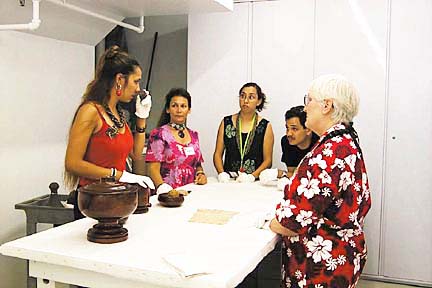

[ SUNDAY TRAVEL ]

Hawaiian treasures MORE than 3 million choice feathers from the now-extinct mamo (black Hawaiian honeycreeper) and o'o (black honey eater) and the endangered i'iwi (scarlet Hawaiian honeycreeper) were used to make the famed red, gold and black skirt of Nahienaena, daughter of King Kamehameha I and Queen Keopuolani. Measuring 5 feet long and 10 feet wide, it is the largest feathered object ever created by Hawaiian artisans.
on display
Bishop Museum's "Behind
the Scenes Tour" shows
artifacts not seen in galleries
By Cheryl Chee Tsutsumi
Special to the Star-BulletinThe magnificent skirt, which dates back at least 175 years, is just one of the treasures that can be seen during Bishop Museum's hourlong "Behind the Scenes Tour."
"This is a once-in-a-lifetime opportunity for many people," says guide Mikiala Ayau. During the tour, visitors enter restricted collections areas to enjoy a rare glimpse of important cultural artifacts not seen in the public galleries, including Queen Lili'uokalani's coronation gown, monarchy jewelry, lei niho palaoa (whale tooth necklaces) and a recording of King Kalakaua's voice made on an Edison wax cylinder (he was the first Hawaiian to be recorded).
What makes this museum tour unique is that with the exception of the royals' jewelry -- which is kept in Plexiglas trays equipped with alarms -- nothing separates the artifacts from onlookers but air.
"This is a collections storage area tour, not a gallery exhibit tour," Ayau said. "There are no display cases in storage areas."
Since the Behind the Scenes Tour was launched a year and a half ago, it has been a "big hit," Ayau said. "Seeing things so special and sometimes sacred is even more meaningful when there is a well-versed Hawaiian person there to share all the little stories about them. Each tour leader has command of the Hawaiian language and history, and so is able to field almost any question. We are able to tailor our talks to the interests of the visitors on the tour."
>> Queen Liliuokalani was Bishop Museum's first official visitor. She visited on June 22, 1891. DID YOU KNOW?
>> The Easter Island statue on the museum's grounds is actually a cement replica. It stands 7 feet tall and measures 6 feet across and 5 feet from its nose to the back of its head.
>> At any given time, Bishop Museum has 1 million insects on loan to researchers around the world (it has a total of 14 million specimens in its insect collection).
>> The museum is the proud owner of the oldest known "case photograph" in Hawaii. It's a daguerreotype portrait of Princess Bernice Pauahi Bishop, thought to have been made in 1847. Case photographs -- including daguerreotypes, ambrotypes and tintypes -- are unique images because they were not made from negatives. The plate that was exposed in the view camera (silver-coated copper plate for daguerreotypes, glass for ambrotypes, iron for tintypes) actually was the final "photo," which was commonly presented in a small case, hence the term.
Address: 1525 Bernice St. BISHOP MUSEUM
Hours: 9 a.m. to 5 p.m. daily except Christmas Day
Admission: $14.95 for adults; $11.95 for seniors age 65 and older and children ages 4 to 12. Kamaaina rates are $7.95 for adults and $6.95 for children. Kids under 4 free.
"Behind the Scenes Tour": 1:30 p.m. Mondays to Fridays. The cost is an additional $15 per person. The tour is limited to 10 people; must be 12 or older. Viewing the museum's free 1 p.m. dramatic presentation, "Ola Na Moolelo" ("the living stories") -- in which costumed performers bring different periods in Hawaiian history to life through acting, storytelling, chant and hula -- is highly recommended because it sets the context for the tour. The current presentation revolves around King Kalakaua.
Phone: 847-3511
Web site: www.bishopmuseum.org
Even newcomers cannot help but be deeply moved when they realize cherished links to Hawaii's past are right at their fingertips. "I have had people weep at the mere sight of the feather cloaks," Ayau said.
"Oftentimes, they are affected by our tour in such a way that they continue their visit here with newfound respect for Hawaii, its resources, people and history.
"People have asked for recommended reading to fill in the parts we ran out of time to cover. I receive letters from people who went on to visit Waipio Valley, Iolani Palace and the Royal Mausoleum and have stood in awe of Hawaii's beauty, her people and their accomplishments instead of just hurriedly snapping a picture and getting back on their tour bus."

The oldest and largest museum in the state, Bishop Museum was founded in 1889 by Charles Reed Bishop in memory of his wife, Princess Bernice Pauahi Bishop, the last direct descendant of the Kamehameha family dynasty. Reed originally established the museum as a repository for his wife's impressive collection of family heirlooms. Over the past 112 years, the institution's acquisitions have grown to include more than 2 million artifacts, specimens, documents and photographs about Hawaii and other Pacific island cultures.Bishop Museum's mission is "to record, preserve and tell the stories of Hawaii and the Pacific, inspiring guests to embrace and experience our natural and cultural world."
In addition to its exhibits, it offers a daily roster of activities that feature hula performances, interactive displays, craft and science demonstrations, multimedia planetarium shows, and guided gallery and garden tours.
Although she has worked at Bishop Museum for 21 years, Betty Kam, collections manager for the Cultural Resource, Collection Care Department, has never lost her fascination for the rich history that surrounds her.
"I am passionate about the museum," she said. "There's always something new and exciting to discover, from how stone was patiently formed into remarkable implements to a funny story about how a photographer learned to use a camera. These encounters have left me with incredible respect for the people who lived before us, and those that work so hard to keep the knowledge and culture alive."